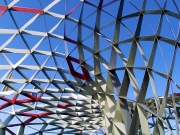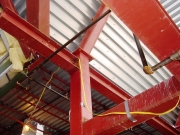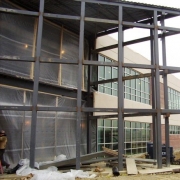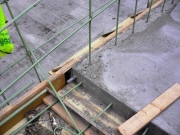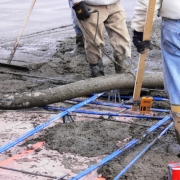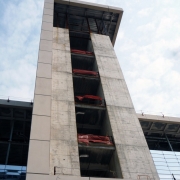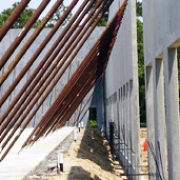- Error
{Re}habitat
Learn how adaptive reuse and upcycling can add hip design to your home, apartment, or yard with the Go Green channel's {Re}habitat series. Follow host Rachael Ranney as she shows you how to repurpose salvaged and found materials, adding fun and function to your space without breaking your budget.

Structural aluminum framing in commercial applications is most commonly used in curtain wall assemblies and as framing members when the building's dead load is an issue. Structural aluminum framing is also used in greenhouses and glass enclosures. In residential construction, structural aluminum is used for custom jobs with large glazed areas, as well as for framing outdoor awnings.
Structural steel framing, which includes structural stainless steel framing, describes the creation of a steel skeleton made up of vertical columns and horizontal beams. This skeleton provides the support for the roof, floors and walls of the structure. There are three main types of structural steel framing systems. They are the clear-span rigid frame structure, the modular structural frame and single slope frame style. Choosing which type of steel frame to use for a given project requires the consideration of a number of factors, including building width, height, location, roofing type, and building use.
Structural metal framing is used in nearly every type of commercial and residential construction. Rigid frame construction forms the skeleton of many buildings. It allows for long and heavy spanning beams, girders, rafters, and columns. Framing can be comprised of various metals and can be made into custom shapes and multiple configurations, providing endless options for project planners.
The majority of Concrete Forming is assembled in the field and allows for cast-in-place concrete to be shaped into slabs, beams, columns, floors and walls used as structural members. Just about any material can be used to create a form, but traditional wood forming and modern pre-fabricated panel systems are the most common types of formwork for cast-in-place concrete. The design of a forming system must consider the basic geometry of the concrete to be formed, the weight of the concrete during placement, the lateral loads (wind forces) and the methods for attachment for additional concrete pours and/or future material attachments. In more complex concrete projects, shoring or falsework is sometimes required as support or scaffolding for the formwork to ensure that the formwork can support the loads and stress being applied by the concrete.
This topic includes information related to site-cast concrete placed during construction. Site-cast concrete is cast in forms on a cured slab and then placed in their final location. Walls are cast adjacent to their final location and then tilted up. Similarly, floor slabs are cast on the ground, one on top of another and then each are lifted into place.
This topic includes information related to precast structural concrete placed during construction. Precast structural concrete is a product that is cast in a controlled environment, delivered to a site and lifted into place. Precast structural concrete has a dull, gray appearance that is commonly concealed behind finishes. It is reinforced with steel and produced for use as beams, columns, girders, joists, hollow core planks, stairs and slabs. Precast structural concrete also offers pre-tensioned and post-tensioned products.
This topic includes information related to precast architectural concrete placed during construction. Precast architectural concrete is a product that is cast in a controlled environment, delivered to a site and lifted into place. Precast architectural concrete is an exposed concrete product that has an aesthetically pleasing, finished appearance. Precast architectural concrete can be formed, faced, pre-tensioned or post-tensioned products.
This topic includes information related to tilt-up concrete placed during construction. Tilt-up concrete or tilt-up construction wall panels are concrete walls that are cast in forms on a cured slab next to their intended location, allowed to cure and then tilted up, into place. Tilt-up concrete wall panels have embedded connectors and attachments, are reinforced with steel, and formed to include openings and reveals within a panel. A crane is used to hoist or tilt the wall panel from it's horizontal position into the intended vertical position.
